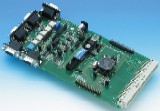
Mercedes uses it, so do BMW, Ducati and even the budget car makers from Korea. CAN-bus is now in just about every mass-produced car, and CAN-connections are set to grow.
Supporting this uptake, and the increasing use of the LIN-bus, are a whole host of microcontrollers, from the simplest 8-pin, 8-bit micro to 32-bit multi-interface devices.
In the 32-bit area Fujitsu reckons there are trends towards bigger memories, perhaps up to 4Mbyte in the near future, and for multiple CAN interfaces, perhaps up to six. “We could also build a LIN-master with 12 or 16 LIN-busses,” says Mathias Bräuer, a design manager at Fujitsu.
Microchip has also been adding CAN and LIN interfaces to its products, starting with CAN, but with at least eight future products listed with LIN.
Most of the ten CAN-bus devices offered by the firm are flash based, and all include timers, comparators and analogue to digital conversion. Memory ranges from 16kbyte to 64kbyte.
The two LIN-bus devices already available from Microchip are lower-end PIC16 devices with 2kwords of OTP. One has an eight-bit ADC, both have an eight-bit timer and a watchdog timer. The fi rm plans to bring out eight further devices with LIN-bus, based around its PIC18 range. These will have up to 128kbyte of flash.
Meanwhile Atmel has just begun sampling a member of its AVR family with an integrated CAN controller, aimed at automotive and industrial. The firm’s AVR family now has 58 devices.
Philips Semiconductors has 80C51 micros with CAN-bus interfaces, either OTP or ROM-less, and with multi-channel ADCs. In its LPC2100/2200 flash memory family the firm has dual and quad-CAN micros, while there is a single CAN microcontroller in the XA.
This availability across three processor families gives quite a choice of performance and peripherals.
Another European firm with a significant investment in CAN is Infineon, with micros covering 8-, 16- and 32-bit. At the high-end Infineon uses its 32-bit TriCore processor to offer three devices aimed at engine management, telematics and audio processor activities. All three devices integrate two full CAN interfaces.
Infineon’s 16-bit devices are generally based around the popular C166 family of micros with either one or two bus interfaces. For the 8-bit devices the company uses its C505/515 cores, either OTP or ROM-less.
STMicroelectronics included CAN support in its latest STR710/720 ranges, which are based around the ARM7 processor core. The STR710 integrates up to 256kbyte of flash. The STR720 adds cache and an MMU to the processor, but memory is off-chip.
CAN also appears in the firm’s ST7, ST9 and ST10 microcontrollers in various forms, from passive to active and with varying mailbox sizes. For example, the passive CAN module supports three Tx/Rx mailboxes and two 11-bit Rx filters. FullCAN is 14 mailboxes and two 29-bit Rx filters and an Rx FIFO. Another version called cCAN has 32 mailboxes.
Some ST7 devices also support LIN through a serial bus.
CAN and LIN
CAN, the controller area network, was developed primarily as a command and control bus by Robert Bosch for automotive systems. With data rates up to 1Mbit/s over 40m and good error detection it has also found uses in industrial control, medical equipment and building control.
There are two general forms of CAN: standard CAN 2.0A using 11-bit identifiers for the message frame, and extended CAN 2.0B using 29-bit identifiers.
ISO standards define the physical layer, with ISO11898 for 1Mbit/s and ISO11519 for 125kbit/s links.
LIN, or local interconnect network, is a lower cost network using a single wire. It is based around the standard UART interface and all bus arbitration is handled by the master node, keeping the slaves as simple as possible.
In automotive, LIN is aimed at lower rate, less critical links such as body electrics. Data rate is 20kbit/s, while clock information is recovered from the data by slave nodes.
Replacing CAN?
For high-end cars there is a demand for a faster, more flexible bus. This could be filled by FlexRay, which gives 10Mbit/s on each of two channels, is time-triggered making it deterministic, and has failsafe mechanisms.
Frank Faoro at Renesas reckons FlexRay is a few years from production: “We can see there will be the first FlexRay applications in 2007.” Fujitsu’s Gerhard Roos is in general agreement: “Perhaps in five years in production.”
The FlexRay consortium was launched in September 2000 by automotive manufacturers BMW and DaimlerChrysler in partnership with Philips Semiconductors and Motorola. Any technologies developed, such as high-speed control applications, are made available to the global automotive market.
 Electronics Weekly
Electronics Weekly



